Beekeeping Annual Calendar
The practice of beekeeping is exactly that, "a practice," and it should be noted that beekeepers often have their own way of doing things. Some beekeepers are very attentive and involved, while others employ a slightly less invasive approach. Whatever type of beekeeper you are, you should adapt the following calendar to meet your needs. Anticipating the needs of your bees can be frustrating at times and unpredictable, but understanding the lifecycle of the bees and what they are doing month-by-month can help you anticipate their needs and the work that must be done to help you and your bees achieve success. Keep in mind that these are suggested dates and will vary based on weather, temperature, pollen loads, nectar flows, and the bees themselves. The following calendar should be considered general information; dates and tasks should be modified to meet your specific needs. You will also notice that there is an "in bloom" section included in spring, summer, and fall months. It is important that you observe the local landscape, noting plants that are in bloom. This gives you key information regarding the resources that are available to the bees during certain times of the year and if supplementation of food and resources may be necessary. Keeping an annual journal documenting your own experiences, successes, and challeges will help you fine tune this calendar as you progress in your beekeeping. Suggested recipes for feeding patties, Honeybee Healthy, and mite treatment patties are available at on the Bee Nutrition and Feeding page.
Download the full PDFSelect a Month:
January and February
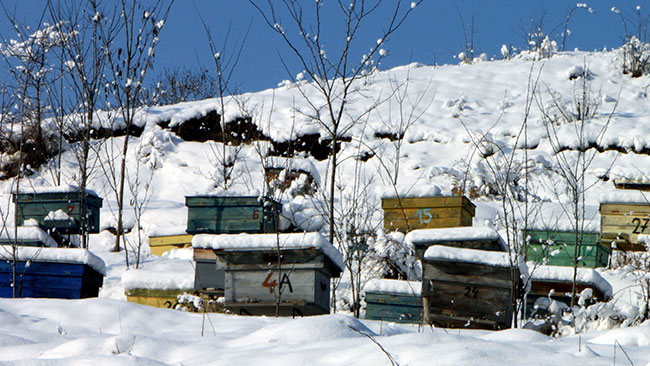
In the Hive
Bees are not particularly active in the cold winter months. They are often found in a tight cluster toward the center of the hive to create warmth. The cluster of bees may move around the hive in order to access honey stores. In order to maintain the internal temperature of the cluster of bees at around 70° F, the cluster can consume up to 1 to 2 pounds of honey per day. On warm days, above 50° F, bees may take a cleansing flight to relieve themselves of waste. It is also common for bees to clean dead bees out of the hive and you may see a buildup of dead bees at the hive entrance. This is normal and should cause no alarm.
Beekeeper Tasks
- If there is snow, clear the entrance to the hive.
- Emergency feeding may be necessary if hives weigh less than 50 to 80 pounds. Add a fondant patty (also called candyboard) to the hive to make sure your bees have enough food. This can be added by quickly lifting the lid, placing the patty, and immediately replacing the lid. Pick a warm day, above 55° F, with little to no wind. (Note that if a fondant patty is added to the hive, the hive will need to be continuously supplemented with food until spring.)
- Order bees and any equipment you may need for spring.
- Check your beekeeping equipment and make sure it is functional. If you need to add or repair anything, now is the time to do it, long before you need to work your bees.
March

In the Hive
Bees can starve during March due to low honey stores. Checking the hive weight is critical and can be done with a simple hive scale, or by gently lifting the hive and assessing the weight. As temperatures warm in March, the amount of brood will begin to increase. Brood production requires more energy resources in the form of sugar, honey, and pollen. Feed with sugar water syrup (1:1) or fondant patty in mid-March to sustain the hive until spring blooming flowers emerge. A pollen patty should also be added to the hive, right above the brood frames. Once you begin to supplement the hive, you must continue until pollen and nectar are abundant in the landscape. A frame count is a quick and easy way to assess how strong the hive is coming out of winter. This is not a substitute for a full hive inspection. This can be done by lifting the lid and counting how many frames have active bees on them. A strong spring hive would be characterized by six or more frames with bees present on a single hive body. As the season progresses, this number should increase.
Beekeeper Tasks
- Check hive weight, bees can easily starve during this time of year.
- Feed bees 1:1 sugar water syrup and pollen patty.
- Remove tar paper or other winterizing gear from the hive when temperatures are consistently above freezing.
- On a warm day (>55° F), get a frame count.
- Change entrance reducer to a larger entrance size.
- If tracheal mites are suspected, test and treat with grease patty or Apiguard.
- Ensure there is a water source that will be available all season.
In Bloom
Dandelion, apricot, willow, birch, pussywillow, forsythia, winter heath, iris, snowdrops, daffodil, tulips, crocus, and other spring bulbs.
April
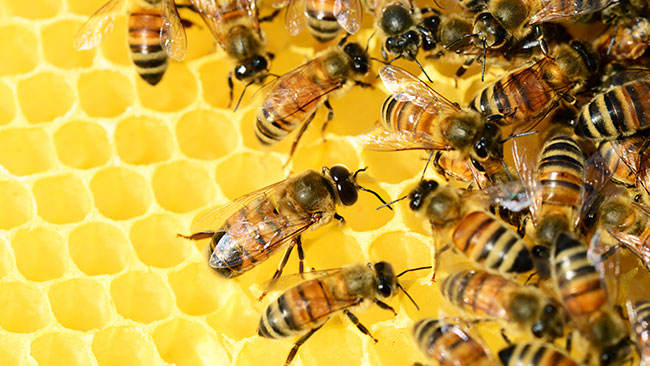
In the Hive
In April, with the presence of pollen and rising temperatures, the brood increases rapidly in anticipation of nectar flows. The presence of pollen on the hind legs of the bees is a good indicator that the hive is producing brood. When pollen and nectar sources are adequate, drones will begin to be produced. Seeing some drone cells is a good indication that the hive is thriving. Early blooming plants such as willow, maple, fruit trees, berries, and dandelion are good sources of early pollen for the hive. Pollen can range in color depending on the source, so look for pollen baskets on the bee's hind legs to be loaded with orange, yellow, creamy white, olive or even red.
Beekeeper Tasks
- On a warm day with temperatures above 55° F, do a full hive inspection. Check for all stages of brood, the brood pattern, and the overall health of the hive.
- Attempt to find the queen. Populations are small in the spring and you have a good chance of spotting her.
- If hives have overwintered, consider splitting the hive to control the population and reduce risk of swarming later in the season.
- Begin monthly check for foulbrood diseases. If an infection is suspected, call your county bee inspector and have the hive checked to verify the disease. Antibiotic treatments can be obtained with a prescription from a veterinarian.
- Feed bees 1:1 sugar water syrup and pollen patty.
- Register hives with the Utah Department of Agriculture and Food (UDAF). This will give you access to the many resources that UDAF offers, including inspections and pest and disease alerts.
In Bloom
Maple, willow, fruit trees, service berry, choke cherry, Oregon grape, berries, wisteria, viburnum, lilac, dandelions, broad beans, barberry, flowering quince, grape hyacinth.
May
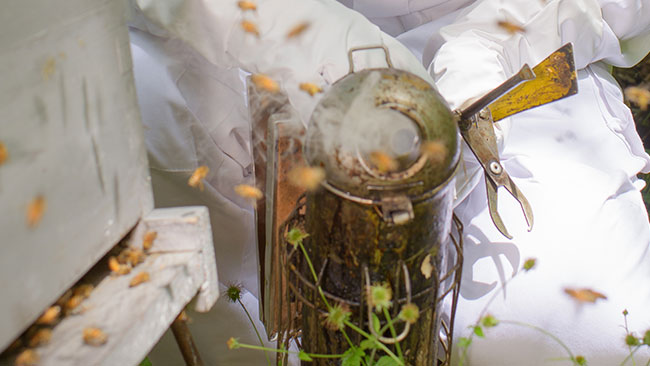
In the Hive
May marks the beginning of swarm season due to rapidly expanding bee populations. This is a natural and normal response for hives that have overwintered as they often reach maximum population mid-spring. Management practices such as adding additional boxes, splitting the hive, and watching for the appearance of new queen cells near the bottom of the frames, can help reduce the chance of swarming. Swarm season typically winds down in July, however bees can swarm any time during the active beekeeping season. Perform a Varroa mite check and treat for mites if there are more than 5 mites per 300 bees (roughly a half cup). Mite checks are encouraged monthly until it is too cold to open the hive. Varroa mites are one of the major stresses on a bee colony. These pests attach to bees, sucking their hemolymph (blood) and can potentially spread as many as 20 viruses. As bees fly between hives, they bring mites with them which may infest other hives. Mites can be present in new hives as well as older, well managed hives, and should be addressed by all beekeepers. Many of the available treatments have temperature limitations and may not be effective if the brood is capped. Make sure to follow the labeled instructions for selected mite controls. Rotate treatments from spring to fall; repeated use of the same chemicals can increase the possibility of resistance to treatments.
Beekeeper Tasks
- Do a full hive inspection, assessing for pollen and nectar stores.
- Assess laying pattern and look for all stages of brood to ensure you have a healthy and active queen. Problems with the queen early in the year can greatly impact hive strength.
- Do a frame count to ensure populations are rising.
- Feed 1:1 sugar water syrup to new colonies until nectar flow is enough to support the colony (nectar flow usually peaks in late May or early June in Utah).
- Watch for and manage swarming behaviors. Adding an additional box to the hive to allow more room or splitting the hive can help prevent swarming.
- Add a honey super when you have seven full frames of capped honey in the top box.
- Do a Varroa mite check and treat if there are more than 5 mites present per 300 (or half cup) bees.
In Bloom
Fruit trees, berries, sumac, rose, gaillardia, salvia, speedwell, St. John's-wort, sweet pea, yarrow, catmint, clover, penstemon, allium, spiraea, strawberry, thyme.
June

In the Hive
June is the peak of nectar flow in Utah and bees are busy foraging and bringing nectar back to the hive. As nectar is brought into the hive it is placed in cells, fanned to dehydrate it, and capped to ensure it does not spoil. Bees will need supers added to the hive as honey stores increase to give the bees additional space to store honey. The target amount of honey that a colony needs to store for winter is 80 to 100 pounds, or 10-12 deep frames covered front and back with capped honey. The average life span of a worker bee in the summer is 5 weeks.
Beekeeper Tasks
- Do a thorough hive inspection, assess laying pattern, and all stages of brood to verify that the queen is healthy and thriving.
- Remove entrance reducer at the beginning of the month.
- Watch for and manage swarming behaviors.
- Add a honey super when you have seven full frames of capped honey in the top box.
- Move full and capped frames of honey to the outside of the box to encourage bees to fill empty frames.
In Bloom
Elderberry, lavender, coreopsis, coneflower, hyssop, bell flower, gaura, lamb's ear, hosta.
July

In the Hive
With high temperatures, you may see bees bearding on the outside of the hive. This is not cause for alarm, the bees are simply trying to cool the hive. This may be a cue that the hive could use some better ventilation. Hive population should be at its peak and it may be difficult to spot the queen. With hive populations high, swarming can still occur. Careful attention to signs of potential swarming should be given when inspecting the hive.
Beekeeper Tasks
- Do a full hive inspection, looking for all stages of brood and capped nectar.
- Make sure that the hive has access to water, especially during hot, dry months.
- Add a honey super when you have seven full frames of capped honey in the top box.
- If bees are bearding, change to a screened bottom board or prop the hive cover open about 1/4" to increase air circulation in the hive. Popsicle sticks or pennies work well.
- Continue to manage the hive to prevent swarming.
- Add supers as necessary.
In Bloom
Sunflower, black-eyed susan, goldenrod, cosmos, Russian sage, sedum, liatris, aster, rose of Sharon, mint, oregano.
August
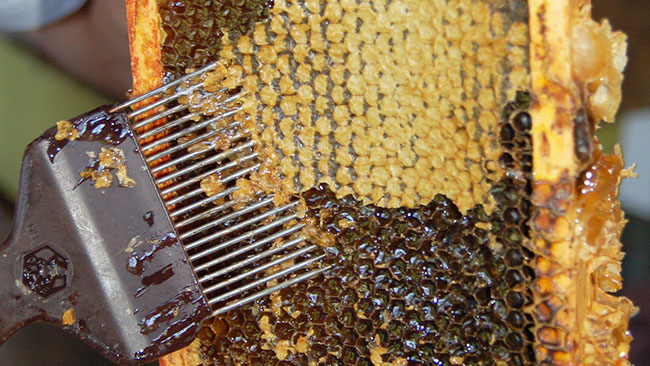
In the Hive
Established hives should have stored well over 100 pounds of honey and harvesting can begin. Bees will need 80 to 100 pounds of capped honey, or 10 to 12 deep frames covered with capped honey on both sides, for winter stores. Don't be discouraged if your new bees haven't produced a lot of honey. The new colony is still building up its numbers. Being able to harvest honey should be considered a bonus for first year hives. Once honey is harvested, you should evaluate the level of Varroa mite and get a fall treatment plan in place. August is when the Varroa mite population explodes. Treatment from now until freezing temperatures is crucial for bee health. Many of the available treatments have temperature limitations and may not be effective if the brood is capped. Make sure to follow the labeled instructions for selected mite controls. By August, the summer nectar flow has tapered off. Bee populations begin to decline and bees are beginning to prepare for winter. If poor laying patterns are observed or if the queen is aging, August is a good time to requeen the hive.
Beekeeper Tasks
- Do a thorough hive inspection, assess laying pattern, check for all stages of brood and assess queen strength.
- Assess hive for brood diseases.
- Check for Varroa mite and provide appropriate treatment if there are more than 5 mites per 300 (or half cup) of bees. It is common for hives to become reinfested after initial fall treatments. Monthly mite checks should continue until the weather becomes too cold to open the hive.
- If honey stores are abundant, begin honey harvest from the honey supers. Do not overharvest. A colony needs 100 pounds, or 10-12 deep frames covered front and back with capped honey for winter stores.
In Bloom
Basil, bee balm, germander, monkshood, goldenrod, aster, sunflower, Russian sage.
September

In the Hive
The hive is starting to slow down and bee populations begin to diminish. The queen starts laying winter brood, and drones begin to leave the hive. Varroa mite populations significantly increase in the fall and can greatly impact the health of winter bees. After initial treatments in the fall, mite reinfestation is common as bees drift from hive to hive. Careful monthly monitoring and additional treatments throughout the fall months may be required to ensure healthy hives and successful overwintering. As nectar and pollen sources taper off in the fall, bees may require supplemental feeding especially if honey stores are light. Feed with 2:1 sugar water syrup until temperatures near freezing or until bees stop taking the syrup. With less nectar and pollen available, robbing is a potential problem, especially in weaker hives. In hive (top or frame) feeders rather than external feeders (Boardman), are recommended at this time of year to discourage robbing from wasps and other bee colonies.
Beekeeper Tasks
- Do a thorough inspection. Verify you have a queen and that she is laying.
- Do a frame count to get an idea of how strong the hive is.
- Assess hive for brood diseases.
- Begin feeding 2:1 sugar water syrup with an in-hive (top or frame) type feeder to increase honey stores and to ensure reserves for winter.
- Install robber screens or reduce entrance to the hive to discourage robbing.
- Weigh hives: hives should weigh about 80 to 100 pounds and have 10 to 12 full deep frames (both front and back) of capped honey for winter stores.
- Honey should be harvested when ambient temperatures are between 80-85° F.
- Continue to monitor and treat for Varroa mite as necessary. Treatment threshold is 5 mites per 300 (or 1/2 cup) of bees. Re-infestation after initial treatment is common.
- If tracheal mites are suspected, test and treat with grease patty.
In Bloom
Basil, bee balm, germander, monkshood, goldenrod, aster, sunflower, Russian sage.
October

In the Hive
Bees are busy preparing for winter, the hive population is beginning to diminish, and the queen is busy building the population of overwintering bees. Winter bees have different physiology that enable them to live in colder temperatures. They also live for much longer than summer bees. Varroa mite reinfestation is common in the late fall. It is critical that the bees continue to be monitored for mites and that appropriate treatments are implemented to give the bees the best opportunity to overwinter.
Beekeeper Tasks
- If temperatures are warm, do a final full hive inspection, assessing honey stores for winter, laying pattern and all stages of brood.
- Assess hive for brood diseases.
- To keep bees from consuming winter honey stores, feed 2:1 sugar water syrup until temperatures drop near freezing.
- Hives kept at high elevations or with little or no protection from harsh winter winds should be wrapped with tar paper or material of your choice.
- Make sure the hive has enough air circulation and that condensation will not drip on the bees over the winter. Wet bees are dead bees.
- Consider building a bee "blanket" or other specialized lid for your hive to absorb excess moisture.
- Change entrance reducer to the smallest opening.
- Consider installing a mouse guard to protect your hive from rodents.
- Secure lid with a large rock or a strap.
In Bloom
Rabbitbrush, chrysanthemum, aster, ornamental grasses.
November

In the Hive
As temperatures drop, it is important not to open the hive cover. Bees begin to cluster at 57° F and will shiver wing muscles to maintain hive temperature (thermogenesis). Opening the hive on a cold or windy day can kill the bees, so care should be taken when adding anything to the hive during winter months.
Beekeeper Tasks
- Be careful opening hive in cold temperatures. If lifting the hive lid is necessary, pick a calm, warm day with temperatures above 55° F and work quickly to prevent heat loss.
- Feed fondant patty if hive weight or honey stores are light.
- Clear snow from hive entrance
December
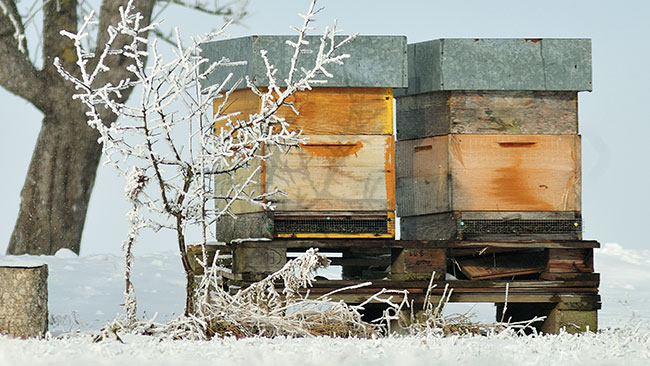
In the Hive
Bees should be disturbed as little as possible in the cold winter months. Bee status can be assessed by knocking on the hive and carefully listening for a buzzing sound. When shoveling walks in the winter, remember to also remove snow from the hive entrance so that bees have a way out of the hive. On warm days, bees may make a quick cleansing flight to rid themselves of waste.
Beekeeper Tasks
- Feed fondant patty if hive weight or honey stores are light.
- Clear snow from hive entrance.


